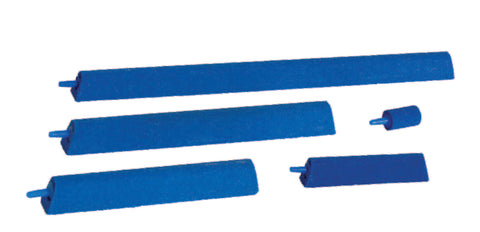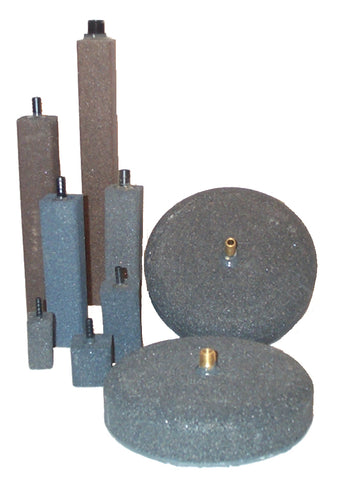Choosing an air stone is much like buying a vehicle. They all accomplish basically the same thing, but some vehicles are better suited to one task than another.
For regular air compressors (not pure oxygen), we sell two kinds of airstones; those made of silica, and those made of aluminum oxide. Here's a quick overview so you can chose the best stone for your purpose:
Silica:

These are the airstones commonly found in aquarium stores. They're available in different colours, like blue, green, or white. They're also available in a very wide variety of sizes, ranging from 1" for small aquariums, up to 12" for large industrial tanks. Silica air stones are often used for studies in laboratories that study toxicology as they are completely free of metal, and therefore are unreactive with most chemicals. In addition, silica airstones are less expensive than alternative materials, and require less pressure from the air compressor than aluminum oxide stones.
Their downfall: silica is not very durable. In fact, just by handling the airstones, you can feel sand crumbling off them. These stones have a finite lifespan, and can only withstand a very gentle cleaning.
Aluminum oxide:

Aluminum oxide stones produce the same size of bubbles as regular silica (fine pore size is also available). By comparison, aluminum oxide airstones are incredibly durable. These will stand up to many years of harsh cleaning and use. Aluminum oxide is the same material that makes up grinder wheels. Although these are available in small sizes, the majority of their use is in industrial, commercial, or large pond applications.
Their downfall: Do not use in glass aquariums as they will vibrate and scratch the glass, eventually breaking it. Also, aluminum oxide creates more back pressure on the compressor, so more pressure is required.
Rectangular Aluminum Oxide Airstones Vs. 7" Domes
Rectangular stones are good for smaller applications: in enclosed tanks, industrial applications. The 7 inch domes are specially designed with a PVC plate on the bottom, so all of the air bubbles are directed either sideways or straight up - none down. This prevents the airstone from digging into soft-bottom ponds, and maximizes the upward flow of water to help circulate your pond at the same time as adding oxygen.
How to Clean Diffusers
Aluminum oxide diffusers are virtually indestructible (although they will break if dropped!) but need occasional cleaning. The frequency of cleaning will be determined by the mineral and organic content in the water. On average, stones will need to be cleaned once per year, but could require as much as every few months.
- remove from the water and blow out remaining water. Scrape off any large debris.
- immerse completely in undiluted muriatic acid to dissolve any buildup. This time varies between one minute to eight hours in extreme cases. Be mindful when working with acid! Wear eye, face, and hand protection and have lots of clear water on hand for diluting splashes or spills.
- remove from acid and rinse thoroughly.
- Dilute the acid with at least ten times as much water before disposing.

